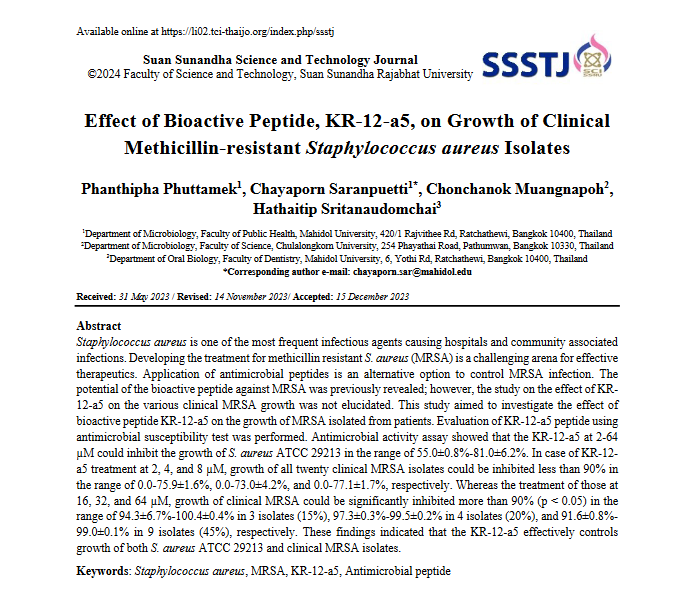Effect of Bioactive Peptide, KR-12-a5, on Growth of Clinical Methicillin-resistant Staphylococcus aureus Isolates
DOI:
https://doi.org/10.53848/ssstj.v11i1.577Keywords:
Staphylococcus aureus, MRSA, KR-12-a5, Antimicrobial peptideAbstract
Staphylococcus aureus is one of the most frequent infectious agents causing hospitals and community associated infections. Developing the treatment for methicillin resistant S. aureus (MRSA) is a challenging arena for effective therapeutics. Application of antimicrobial peptides is an alternative option to control MRSA infection. The potential of the bioactive peptide against MRSA was previously revealed; however, the study on the effect of KR-12-a5 on the various clinical MRSA growth was not elucidated. This study aimed to investigate the effect of bioactive peptide KR-12-a5 on the growth of MRSA isolated from patients. Evaluation of KR-12-a5 peptide using antimicrobial susceptibility test was performed. Antimicrobial activity assay showed that the KR-12-a5 at 2-64 μM could inhibit the growth of S. aureus ATCC 29213 in the range of 55.0±0.8%-81.0±6.2%. In case of KR-12-a5 treatment at 2, 4, and 8 μM, growth of all twenty clinical MRSA isolates could be inhibited less than 90% in the range of 0.0-75.9±1.6%, 0.0-73.0±4.2%, and 0.0-77.1±1.7%, respectively. Whereas the treatment of those at 16, 32, and 64 μM, growth of clinical MRSA could be significantly inhibited more than 90% (p < 0.05) in the range of 94.3±6.7%-100.4±0.4% in 3 isolates (15%), 97.3±0.3%-99.5±0.2% in 4 isolates (20%), and 91.6±0.8%-99.0±0.1% in 9 isolates (45%), respectively. These findings indicated that the KR-12-a5 effectively controls growth of both S. aureus ATCC 29213 and clinical MRSA isolates
References
Caiaffa, K. S., Massunari, L., Danelon, M., Abuna, G. F., Bedran, T. B. L., Santos-Filho, N. A., … Duque, C.(2017). KR-12-a5 is a non cytotoxic agent with potent antimicrobial effects against oral pathogens.Biofouling, 33(10), 807-818. doi:10.1080/08927014.2017.1370087
Cerini, P., Meduri, F. R., Tomassetti, F., Polidori, I., Brugneti, M., Nicolai, E., … Broccolo, F. (2023). Trends in antibiotic resistance of nosocomial and community-acquired infections in Italy. Antibiotics, 12(4), 651.doi:10.3390/antibiotics12040651
CLSI. (2018). M07 Methods for dilution antimicrobial susceptibility tests for bacteria that grow aerobically (11thed.). Pennsylvania: Clinical and Laboratory Standards Institute.
Jacob, B., Park, I. S., Bang, J. K., & Shin, S. Y. (2013). Short KR-12 analogs designed from human cathelicidin LL-37 possessing both antimicrobial and antiendotoxic activities without mammalian cell toxicity. Journal of Peptide Science, 19(11), 700-707. doi:10.1002/psc.2552
Kim, E. Y., Rajasekaran, G., & Shin, S. Y. (2017). LL-37-derived short antimicrobial peptide KR-12-a5 and its D-amino acid substituted analogs with cell selectivity, anti-biofilm activity, synergistic effect with conventional antibiotics, and anti-inflammatory activity. European Journal of Medicinal Chemistry, 136,428-441. doi:10.1016/j.ejmech.2017.05.028
Li, H., Zhang, S., Nie, B., Long, T., Qu, X., & Yue, B. (2019). KR-12-a5 reverses adverse effects of lipopolysaccharides on HBMSC osteogenic differentiation by influencing BMP/Smad and P38 MAPK signaling pathways. Frontiers in Pharmacology, 10, 639. doi:10.3389/fphar.2019.00639
Ming, L., & Huang, J. A. (2017). The antibacterial effects of antimicrobial peptides OP-145 against clinically isolated multi-resistant strains. Japanese Journal of Infectious Diseases, 70(6), 601-603. doi:10.7883/yoken.JJID.2017.090
Otto, M. (2012). MRSA virulence and spread. Cellular Microbiology, 14(10), 1513-1521. doi:10.1111/j.1462-5822.2012.01832.x
Synpeptide. (2015). Custom peptide synthesis. Retrieved from http://www.synpeptide.com/custom.asp?id=15
Xhindoli, D., Pacor, S., Benincasa, M., Scocchi, M., Gennaro, R., & Tossi, A. (2016). The human cathelicidin LL-37-a pore-forming antibacterial peptide and host-cell modulator. Biochimica et Biophysica Acta - Biomembranes, 1858(3), 546-566. doi:10.1016/j.bbamem.2015.11.003

Downloads
Published
How to Cite
Issue
Section
License
Copyright (c) 2024 Suan Sunandha Rajabhat University

This work is licensed under a Creative Commons Attribution 4.0 International License.











